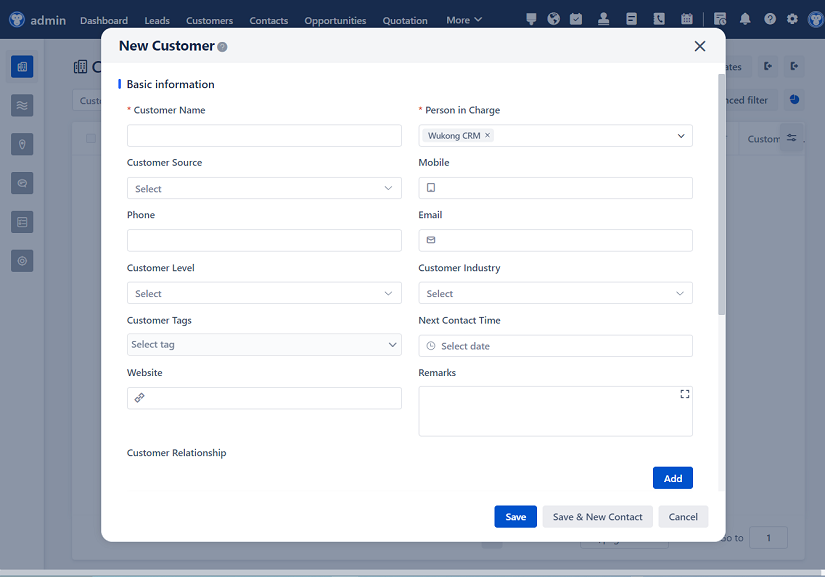
△Click on the top right corner to try Wukong CRM for free
You know, when I first started digging into CRM systems—Customer Relationship Management systems—I was kind of overwhelmed. I mean, there’s so much going on behind the scenes: sales tracking, customer data, marketing automation, support tickets… it’s a lot. But one thing that really stood out to me after a while was how important organizational structure and permission design actually are. Like, seriously, they’re not just technical details you can gloss over. They shape how people work, what they can see, and even how decisions get made across teams.
So let me break this down in a way that makes sense, because honestly, I wish someone had explained it to me like this earlier. Think about your company for a second. Do you have departments? Sales, marketing, customer service, maybe finance or IT? Of course you do. And each of those teams has different roles, right? A sales rep doesn’t need access to payroll data, and a support agent probably shouldn’t be editing pricing strategies. That’s where organizational structure comes into play.
Free use of CRM system: Free CRM
In a CRM system, the way you set up your organizational hierarchy directly affects how information flows. If your CRM mirrors your actual company structure—say, regional offices, team leads, individual contributors—then permissions can be assigned logically. You don’t want chaos, where everyone sees everything. That’s a recipe for data leaks, mistakes, and frankly, confusion.
I remember working with a client once who had their CRM set up with flat permissions. Everyone could view every account. Sounds convenient, right? Well, turns out it wasn’t. Salespeople were stepping on each other’s toes, managers couldn’t track performance accurately, and sensitive client info was visible to interns. It was a mess. After we restructured the org model in the CRM and layered in proper permissions, things calmed down almost immediately. People knew their lanes, accountability improved, and data security got a huge boost.
Now, here’s the thing: organizational structure in a CRM isn’t just about copying your org chart. It’s about designing a digital version that supports your business processes. For example, if your sales team is split by region—North America, EMEA, APAC—you’d want those divisions reflected in the CRM. Then, within each region, you might have team leads and individual reps. The system should allow you to assign records (like customer accounts or leads) based on these units.
And permissions? Oh man, permissions are where the rubber meets the road. You’ve got to think carefully about who can do what. Can a junior sales rep create new deals? Sure. Should they be able to delete them? Probably not. Can a marketing coordinator view all customer contact details? Maybe, but only if it’s necessary for campaign management. Should they be able to edit contract terms? Absolutely not.
Most modern CRMs use role-based access control (RBAC), which is a fancy way of saying “you get access based on your job.” So instead of assigning permissions one by one to each person—which would be a nightmare—you define roles like “Sales Manager,” “Support Agent,” or “Marketing Analyst,” and attach specific permissions to each role. Then, when someone joins the team, you just assign them the right role, and boom—they have exactly the access they need, nothing more, nothing less.
But here’s a pro tip: don’t make too many roles. I’ve seen companies create 30+ custom roles, and it becomes impossible to manage. Keep it simple. Use broad roles and then layer in exceptions only when absolutely necessary. Otherwise, you’ll spend more time tweaking permissions than actually using the CRM.
Another thing people overlook is record ownership. In a CRM, every piece of data—every lead, every account, every opportunity—should have an owner. That doesn’t mean only that person can see it, but they’re responsible for it. Ownership ties directly into permissions. For example, a sales rep owns their leads, so they can edit them freely. Their manager might have “read-write” access to all leads in their team, but other reps can only see shared or public records.
This brings up sharing rules. Most CRMs let you set up automatic sharing based on criteria. Like, “all accounts in the Northeast region should be visible to the Northeast sales team.” Or “support cases with high priority should be visible to the escalation team.” These rules help balance privacy with collaboration. You don’t want silos, but you also don’t want oversharing.
I’ll tell you something else I learned the hard way: always involve stakeholders when designing permissions. Don’t just let IT or the CRM admin decide everything in a vacuum. Talk to the sales director, the head of support, the marketing lead. Ask them, “What do your people need to do their jobs?” and “What should they not be able to do?” Because if you build a system that’s too restrictive, people will find workarounds—like exporting data to spreadsheets or using personal tools—and that defeats the whole purpose of having a CRM.
Also, consider scalability. Your startup might only have five people now, but what happens when you grow to 50 or 500? If your permission model is too rigid or too chaotic, it’ll break under pressure. Build with growth in mind. Use hierarchical roles so that managers automatically inherit access to their team’s data. Set up clear policies for onboarding and offboarding—because when someone leaves the company, you don’t want them still having access to customer data.
And speaking of offboarding—permissions aren’t just about access, they’re about compliance too. Depending on your industry, you might be dealing with GDPR, HIPAA, or other regulations. You can’t afford to have unauthorized people viewing sensitive customer information. A well-designed permission system helps you stay compliant by ensuring data is only accessible to those who need it.
One thing that surprises people is how much psychology plays into this. When employees feel trusted but also accountable—like they have the right access but know there are limits—they tend to use the system more responsibly. But if they feel micromanaged or locked out, they get frustrated and disengage. So it’s not just about security; it’s about user experience and trust.
Let me give you a real-world example. A software company I worked with had a problem: their sales team wasn’t updating deal stages regularly. Why? Because the CRM was set up so that only managers could move deals past certain stages. The reps felt like they were being babysat. Once we adjusted the permissions to allow reps to update stages but required manager approval for final closes, engagement shot up. People felt empowered, but oversight was still there.
Another big factor is field-level permissions. This means controlling not just who sees a record, but which fields within that record they can view or edit. For instance, a customer’s credit limit might be visible only to finance and senior sales managers. Or salary expectations in a recruitment CRM might be hidden from junior recruiters. Field-level control adds another layer of precision to your permission design.
And don’t forget about audit trails. A good CRM logs who did what and when. So if someone deletes a key account or changes a contract value, you can trace it back. This isn’t about spying on people—it’s about accountability and recovery. Plus, it’s super helpful during audits or investigations.
Now, none of this happens overnight. Designing a solid organizational structure and permission model takes time. You’ll probably go through a few iterations. Start small, test with a pilot group, gather feedback, and refine. Involve power users—they’re usually the ones who spot issues early.

Also, document everything. Seriously. Write down your role definitions, sharing rules, and approval workflows. Otherwise, six months later, no one will remember why “Regional Director East” has access to export reports but “Regional Director West” doesn’t. Documentation saves headaches.
Training is another must. Just because you’ve built a beautiful permission system doesn’t mean people will understand it. Run workshops. Show them what they can do, what they can’t, and why. Explain the logic behind the restrictions. When people understand the “why,” they’re way more likely to cooperate.
And finally, review permissions regularly. People change roles, teams restructure, projects end. What made sense last quarter might not fit today. Schedule quarterly permission audits. Remove access for folks who’ve moved on. Update roles as responsibilities evolve. Treat your CRM permissions like a garden—needs regular weeding and pruning to stay healthy.

Look, I get it. Organizational structure and permission design sound dry and technical. But they’re actually at the heart of whether your CRM succeeds or fails. Get them right, and your team works smoothly, data stays secure, and decisions are based on accurate info. Get them wrong, and you’ll deal with frustration, errors, and maybe even compliance risks.

So take the time. Think it through. Talk to your team. Build a system that reflects how your organization really works—not just how you wish it worked. Because at the end of the day, a CRM is only as good as the people using it and the structure supporting them.
FAQs (Frequently Asked Questions):
Q: What’s the difference between organizational structure and permission design in a CRM?
A: Great question. Organizational structure is about how you map your company’s teams and hierarchy inside the CRM—like regions, departments, or reporting lines. Permission design is about controlling what people in those structures can actually do, like view, edit, or delete data.
Q: Can I change permissions after the CRM is live?
Absolutely. In fact, you probably will. Most companies adjust permissions as they learn what works. Just make sure you communicate changes clearly so users aren’t caught off guard.
Q: Should every employee have a CRM login?
Not necessarily. Only people who need to interact with customer data or processes should have access. Giving logins to everyone increases risk and licensing costs.
Q: How do I handle contractors or temporary staff?
Set up time-limited roles with restricted permissions. Make sure their access automatically expires or is reviewed frequently. Better safe than sorry.

Q: What if two departments need to collaborate but have different permission levels?
Use sharing rules or cross-functional teams within the CRM. You can grant temporary or conditional access without giving full permissions.
Q: Is it possible to have too many restrictions?
Yes, definitely. Over-restricting kills productivity. If users can’t do basic tasks without approvals, they’ll bypass the system. Balance security with usability.
Q: Who should be in charge of managing CRM permissions?
Usually, it’s a joint effort between IT, the CRM admin, and department leaders. HR often helps during onboarding/offboarding. Clear ownership prevents confusion.
Q: Can CRM permissions help with data privacy laws like GDPR?
Yes! Proper permissions ensure only authorized personnel access personal data, which is a core requirement of GDPR and similar regulations.
Q: What’s the most common mistake companies make with CRM permissions?
Hands down, it’s giving too much access too quickly—especially admin rights. Start with least privilege and expand only when needed.
Q: How often should we audit our CRM permissions?
At least once per quarter. More often if you’re growing fast or handling highly sensitive data. Regular checks keep things clean and compliant.
Related links:
Free trial of CRM
Understand CRM software

△Click on the top right corner to try Wukong CRM for free